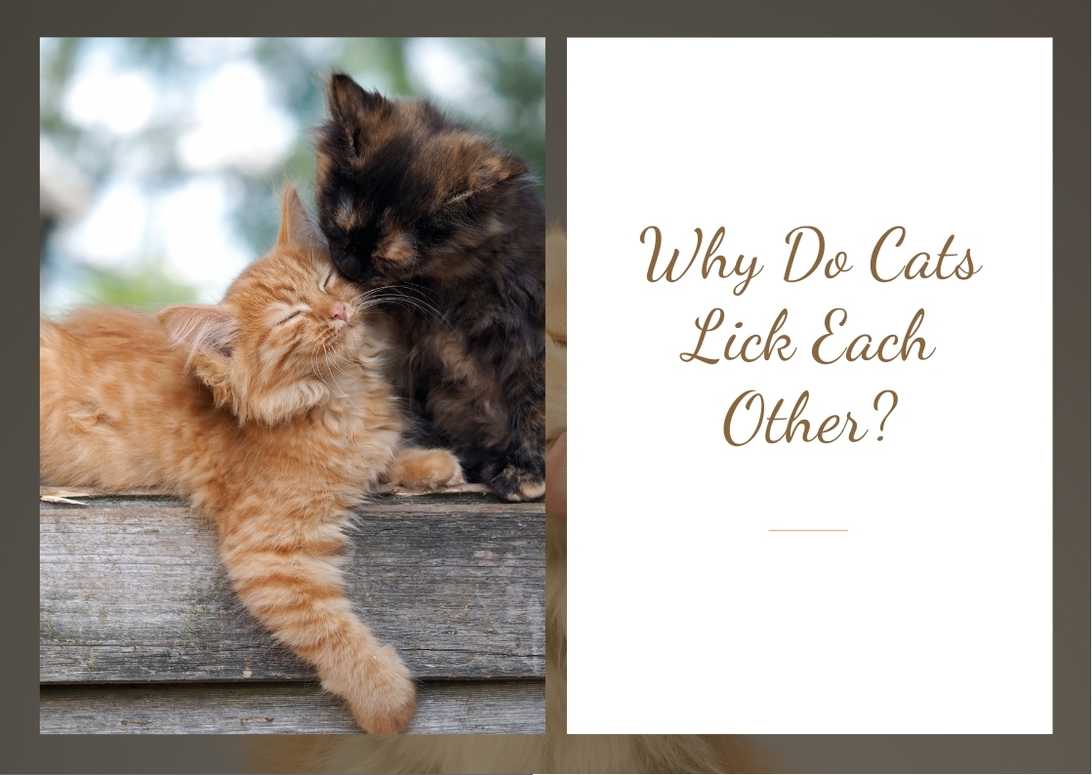Why Do Cats Lick Each Other?
Cats are fascinating creatures with unique behaviors that often leave us wondering what goes on in their furry little heads.
One behavior that never fails to capture my attention is when cats lick each other. It’s a sight that seems both adorable and intriguing, prompting the question: why do cats engage in this behavior?
In this article, we will explore the various motivations behind why cats lick each other, from building bonds and communication to grooming and survival instincts.
When cats lick each other, it’s not just about keeping their fur clean (although that is certainly a perk!). Licking serves as a way for them to show affection and build strong bonds with one another.
Just like humans enjoy hugging or holding hands, cats express their love through grooming rituals. By licking each other, they create a sense of closeness and trust within their social group.
It’s heartwarming to witness these sweet moments of affection between feline friends, as they demonstrate the deep connections they share through such simple gestures.
So let’s dive deeper into the reasons behind why cats engage in this behavior and uncover the fascinating insights into their world of licks and purrs.
Important Points
- Cats lick each other as a way to show affection and build strong bonds.
- Licking serves as a way for cats to communicate and reinforce their social connection.
- Mutual grooming helps establish hierarchy and maintain harmony within the cat community.
- Grooming rituals help maintain cleanliness and good hygiene for cats.
Reasons for Licking
When cats lick each other, it’s not just about grooming, it’s a heartwarming display of love and trust between furry friends.
Cats have a natural instinct to groom themselves, and when they extend this behavior to their feline companions, it signifies a deep bond.
Through licking, cats are not only keeping each other clean but also reinforcing their social connection. It’s their way of saying, ‘You’re important to me,’ and building a sense of security within their group.
This act of grooming goes beyond simple hygiene; it’s an expression of affection that strengthens the emotional ties between cats.
The act of licking also helps in establishing hierarchy and maintaining harmony within the cat community.
By grooming one another, cats engage in mutual scent exchange. They leave behind their unique scent which acts as a form of communication among them.
This scent serves as a reassurance for both parties involved and creates familiarity within the group. It helps establish a shared identity and reinforces the notion that they belong together.
So when you see your cats engaging in this loving behavior, know that it goes beyond mere cleaning – it’s an essential aspect of affection and bonding between them.
Now let’s delve deeper into how licking relates to affection and bonding between cats…
Affection and Bonding
Witness the heartwarming bond between feline companions as they express their deep affection through gentle grooming, creating a beautiful display of friendship that will captivate your heart.
When cats lick each other, it’s not just about cleanliness, but also a way for them to strengthen their bond. It’s like a loving embrace in the feline world, where they show their trust and love for one another.
Through this act of grooming, cats are able to communicate their affection and establish social bonds with each other. It’s their way of saying ‘I care about you’ and ‘You’re an important part of my life.’
As they lick each other’s fur, they not only remove dirt and debris but also create a shared scent that helps them recognize each other as part of the same group or family. This shared scent acts as a form of social currency among cats, helping them feel more secure and connected in their relationships.
So, next time you see your furry friends engaging in this adorable behavior, remember that it goes beyond just cleaning themselves. It is a testament to the strong emotional connection between them as they navigate life together.
From here, we delve into how cats use licking as a means of communication and socializing with both humans and fellow feline companions alike.
Communication and Socializing
Through their gentle grooming rituals, feline companions create a language of love and connection, using licks as a heartfelt way to communicate and build social bonds. When cats lick each other, it’s not just about hygiene or removing dirt from their fur. It goes much deeper than that.
Licking is a form of communication and socializing among cats. It allows them to exchange scents, which helps in identifying each other and strengthening their bond. By licking one another, they’re essentially saying, ‘You’re part of my family, my trusted companion.’ It’s their way of showing affection and reaffirming their relationship.
Furthermore, when cats lick each other’s heads, it signifies an even higher level of trust and intimacy. This act demonstrates that they feel safe in each other’s presence. Through grooming, cats also establish hierarchy within their group. The cat being groomed may be seen as the subordinate or younger member seeking protection and guidance from the older or more dominant cat. This mutual grooming helps maintain harmony within the feline community.
As cats communicate through licking to foster social connections, they also use this behavior to maintain cleanliness and good hygiene.
Grooming and Hygiene
Take a moment to imagine how refreshing it must feel when your furry feline friend lovingly tends to their own grooming needs. Cats are meticulous groomers, and they spend a significant amount of time licking themselves to keep their fur clean and free from dirt or parasites.
However, grooming doesn’t stop at self-care for cats. They also engage in grooming each other as a way to strengthen their bond and show affection.
When cats lick each other, they are not only providing hygiene assistance but also reinforcing social connections with their fellow feline companions. It’s a display of trust and friendship between them.
By grooming each other, cats exchange scents, which helps them recognize one another as part of the same group. This communal grooming ritual serves to establish hierarchy within the cat community by maintaining social order and harmony among them.
So, next time you witness your cats engaging in this mutual grooming behavior, appreciate the deeper meaning behind it as they continue to strengthen their bonds while keeping themselves immaculate.
Establishing Hierarchy
Immerse yourself in the fascinating world of feline hierarchy as your furry friends engage in a grooming ritual that solidifies their social order and strengthens their bond.
When cats lick each other, it’s not just about cleanliness or affection, but also about establishing dominance within their group. You may notice that one cat takes on the role of the ‘groomer’ more often than the other, asserting its higher status. This act of grooming allows the dominant cat to exert control over the submissive one, reinforcing their position in the hierarchy.
As cats groom each other, they are also exchanging scents and marking each other with their own scent. This helps them create a shared scent profile, which is essential for identifying members of their social group and recognizing outsiders.
By licking and grooming one another, cats strengthen their bond and build trust among themselves. It’s truly fascinating to witness how this seemingly simple act plays such a crucial role in maintaining social harmony among our feline friends.
Now let’s transition into exploring another intriguing aspect of cats’ behavior: how grooming serves as a form of stress relief for them.
Stress Relief
Establishing hierarchy among cats is not the only reason they lick each other. Cats also engage in grooming as a means of stress relief. Just like humans find comfort in activities like taking a warm bath or getting a massage, cats use grooming as a way to relax and unwind.
When cats groom each other, it releases endorphins, which are feel-good hormones that help reduce anxiety and promote relaxation.
In addition to providing physical relief, grooming also helps strengthen the bond between cats. It creates a sense of trust and familiarity between them, making them feel more secure in their environment. By licking each other, cats are essentially saying “I trust you”and showing their affection towards one another.
This communal grooming behavior serves as a way for cats to connect with each other emotionally and establish social harmony within their group.
As we move on to discussing the survival instinct behind cat licking, it’s important to note that this behavior goes beyond just establishing hierarchy or relieving stress.
Survival Instinct
You’ll be fascinated to learn that when cats groom one another, it’s actually a survival instinct kicking in! Cats are naturally clean animals and grooming plays a crucial role in their overall well-being.
When they lick each other, they not only bond and show affection, but they also help to keep each other clean and free from parasites. This grooming behavior stems from their ancestors’ need to remove dirt, debris, and pests from their fur to prevent infections or infestations.
In the wild, cats rely on mutual grooming as a way to maintain good hygiene and ensure their survival. By licking each other’s fur, they can remove any potential threats such as ticks or fleas that may have latched onto their companion. Additionally, this act of grooming helps them spread natural oils throughout their coat, which keeps it healthy and provides insulation against the elements.
Furthermore, when cats groom each other, they strengthen their social bonds within the group. This is especially important for feral or outdoor cats who live in colonies. By grooming one another, they establish trust and cooperation among themselves, creating a sense of unity that increases their chances of survival in harsh environments.
So next time you witness your cats engaging in mutual grooming sessions, remember that it’s not just about showing affection; it’s an ingrained behavior driven by their instinctual need for cleanliness and survival.
Frequently Asked Questions
Can cats get sick from licking each other?
Yes, cats can get sick from licking each other. According to a study, approximately 50% of cat-to-cat diseases are transmitted through grooming. So it’s important to ensure their health and hygiene.
How can I encourage my cats to groom each other?
To encourage my cats to groom each other, I can start by providing a calm and comfortable environment. I can also use positive reinforcement and rewards when they engage in grooming behaviors together.
Is it normal for cats to lick each other’s ears?
Yes, it is completely normal for cats to lick each other’s ears. It’s a sign of affection and grooming. Cats have a unique bond and showing love through grooming, including licking each other’s ears, is a common behavior among them.
Why do cats sometimes groom each other’s paws?
Cats sometimes groom each other’s paws as a way to show affection and strengthen their bond. It’s a sign of trust and camaraderie between feline friends, just like when they lick each other’s heads or clean each other’s fur.
Do male cats groom each other as often as female cats do?
Male cats groom each other just as often as female cats do. It’s heartwarming to see them bond through grooming, like a gentle dance of love and trust between furry partners in crime.
Conclusion
In conclusion, the act of cats licking each other serves multiple purposes beyond just grooming. It’s a form of affection and bonding, allowing cats to strengthen their social relationships and trust in one another.
Through this behavior, cats also communicate with each other, conveying messages and establishing their hierarchy within a group. Additionally, licking provides stress relief for cats, helping them relax and feel more secure in their environment.
But perhaps the most fascinating aspect of this behavior is its connection to survival instincts. Cats instinctively groom themselves to keep clean and free from parasites, and by extension, they groom each other as a way of ensuring the health and well-being of their social group.
It’s truly remarkable how such a simple act can encompass so much meaning in the feline world.
So next time you catch your furry friends engaged in a grooming session together, remember that it goes far beyond just cleaning fur – it’s an expression of love, communication, hierarchy establishment, stress relief, and even survival! The bond between two cats sharing comforting licks is like witnessing the harmony of a symphony orchestra or seeing colors explode on a canvas – pure magic!








